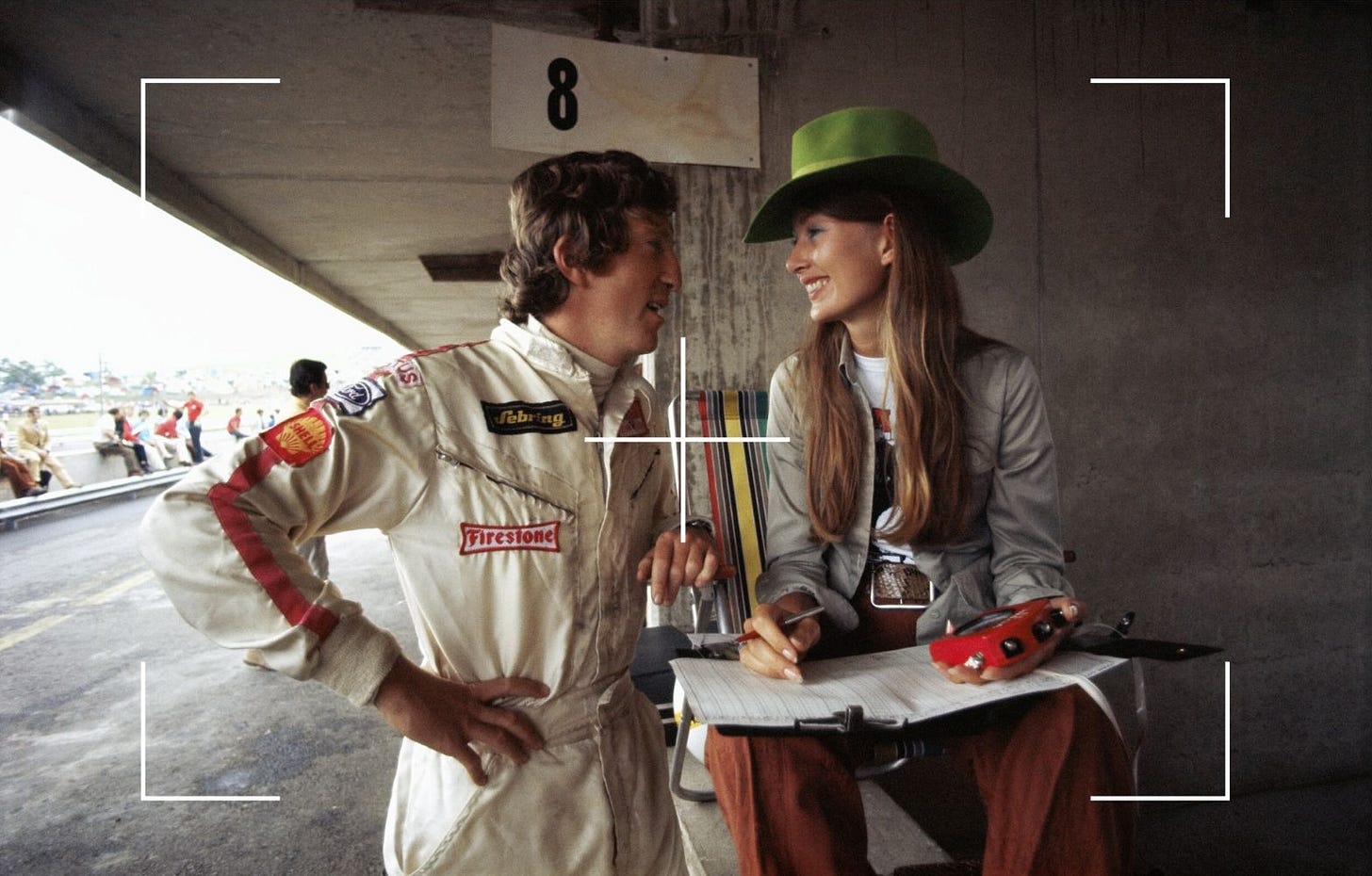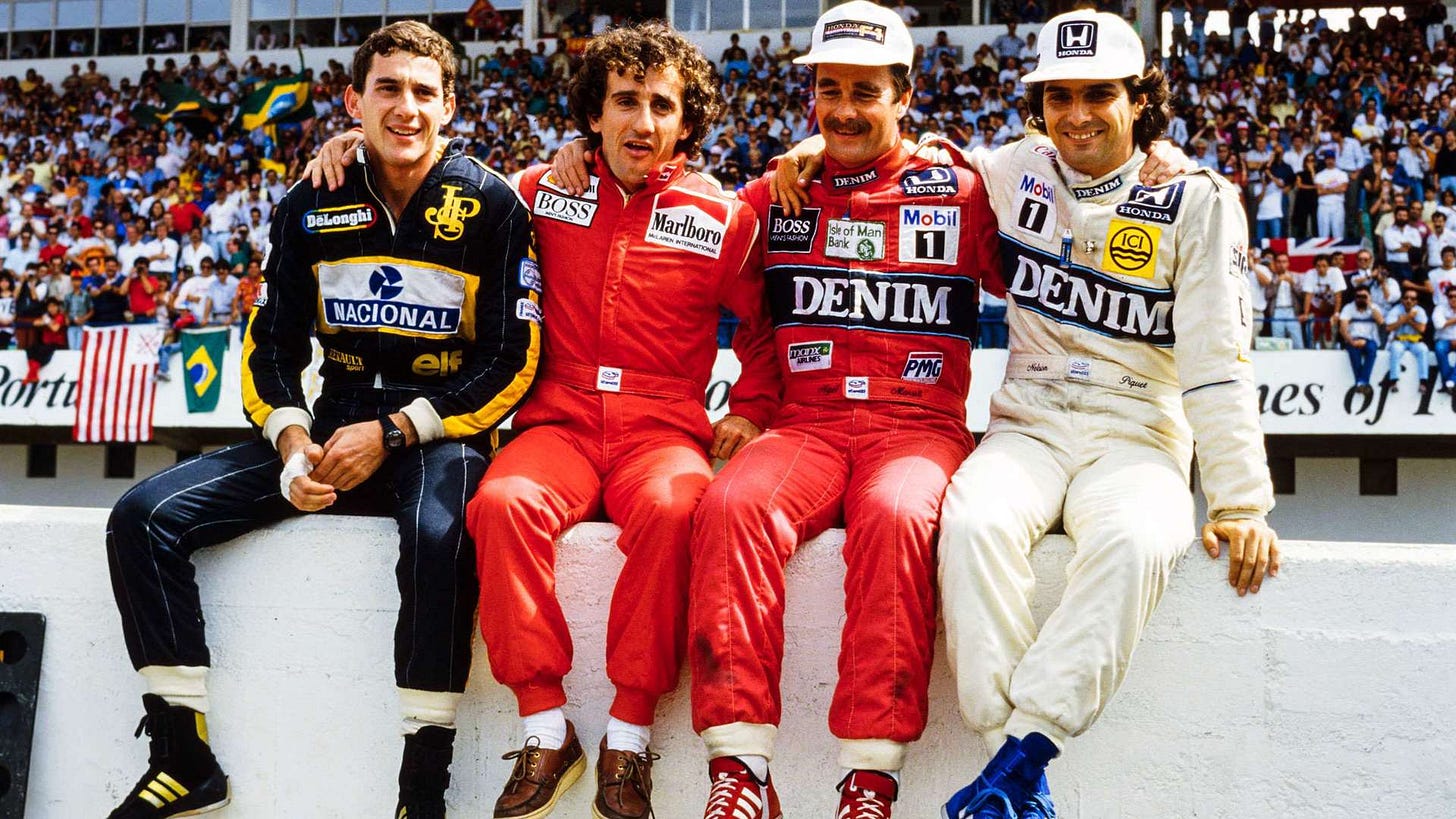Fashion Evolution in Formula 1
From Effective Race wear to Visual Statements, and now the "Fastest Billboards".
Thank you for being here. You are receiving this email because you subscribed to Idée Fixe, the newsletter for curious minds. I’m Toni Cowan-Brown, a tech and F1 commentator. I’ve spent the past five years on the floor of way too many F1, FE, and WEC team garages, learning about the business, politics, and tech of motorsports. I hope you’ll stick around.
How has fashion developed in Formula 1 over the decades?
I was asked a great question the other day - how has fashion developed in Formula 1 over the decades? Formula 1 has certainly undergone quite the transformation in the past seven decades in terms of its own fashion, evolving from purely functional racewear to a powerful tool for branding, personal expression, and fan engagement. So let’s look at how it started, how we got here, so we can understand where we are heading with the likes of Adidas, Puma, Tommy Hilfiger and LVMH now entering this space.
As the 2025 Formula 1 season kicked off this past weekend with the Louis Vuitton Australia race weekend - one of the most fashion-forward GPs we have on our calendar - I thought why not dig into the history and evolution of fashion in Formula 1.
I’m no expert on this topic, so if this is an intersection you are interested in, I suggest following these people: Daniel-Yaw Miller, Rashi Gaur, and Noelle Faulkner, who kindly shared a few insights from her F1 weekend with me for this newsletter.
Function over style
In the early decades, fashion played little role beyond ensuring driver safety and there were few fashion brands involved in the space. We now look back at it and all we see is cool vintage race suits, overalls, patches… But the reality is that during the 1950s and 1960s, drivers often wore everyday clothing or simple overalls, with some even racing in short-sleeved shirts. It wasn’t until the tragic accidents of the era that fire-resistant suits became mandatory in the 1960s, prioritizing protection over aesthetics. The primary focus was safer, more effective racewear rather than making any kind of visual statement.
Fun fact, the first time that the FIA (F1’s governing body) allowed both teams and drivers to advertise sponsors on their liveries and helmets was 1968 and Bernie Ecclestone, who was Jochen Rindt’s manager at the time slapped a paper on his helmet with the words ‘$this space to let’ - it did the job. Watch the video here.
Branding & Commercialization
By the 1980s and 1990s, fashion in F1 took on a new dimension with the rise of commercial sponsorship (which lives on today remarkably). Race suits, team uniforms, and even casual paddock attire became prime real estate for branding, with sponsor logos covering nearly every inch of fabric. Teams leaned into bold color schemes and striking designs to increase visibility, with McLaren’s red-and-white Marlboro-liveried suits and Benetton’s bright, multi-colored designs standing out as iconic looks of the era. Clothing wasn’t just about safety anymore, it was a tool for marketing, turning drivers into walking billboards and reinforcing team identities - as fans, we’ve now also become these billboards happily paying for this privilege, may I add.
Sponsorship visibility became so big that the traditional laurel wreaths that the winners adorned on the podiums quickly disappeared as they obstructed the sponsors on the race suits during the ‘money shots’.
Fashion as a Cultural & Commercial Force
Then as F1 expanded its global reach in the 2000s and 2010s, fashion became a key part of the sport’s culture both on and off the track, as it did in many other sports. Luxury brands like Hugo Boss partnered with teams, elevating the style of team apparel, while drivers began using fashion to express their personalities.
Lewis Hamilton, in particular, became a trendsetter, pushing the boundaries with bold outfits and luxury collaborations, while others, like Daniel Ricciardo, embraced a more playful and streetwear-inspired look.
A New Era of Formula 1 with LVMH
Today, fashion in F1 is bigger than ever, with teams and drivers actively shaping the industry’s intersection with streetwear, luxury brands, and fan culture. Collaborations between teams and fashion houses - such as Mercedes with Tommy Hilfiger and Alfa Romeo (now Stake F1 Team KICK Sauber) with Palace - are redefining team merchandise, making it desirable beyond the racetrack. The big question remains - will F1 fans wear F1 merch the same way football and baseball fans wear team jerseys and baseball caps away from the stadiums? The NFL, for example, has just hired its first-ever Fashion Editor.
Meanwhile, the paddock has become a runway, with drivers like Hamilton making headlines for their race-weekend outfits. With F1’s growing younger and lifestyle-driven audience, fashion is no longer just a side note in motorsport - it’s a key part of its modern identity. This is very much being pushed forward by the new generation of fans, drivers, and partners like LVMH.
According to journalist and cultural strategist, Noelle Faulkner, what we saw this weekend during the Louis Vuitton Australian Grand Prix (official full name) was “the final missing piece of the puzzle around F1 and Fashion’s relationship to it.” For years we’ve had this discussion, “but we’ve been waiting for the moment when fashion would play in this space in a meaningful way”, and according to Faulkner, that moment finally came this weekend during the Australian GP. In other words, “the ‘LVMHification’ was exciting to see, it certainly elevated the experience for everyone and it was everywhere. They are going to see an ROI from this weekend”, and probably in more ways than one. But really she adds, “I’m just happy this is opening new ways to talk about Formula 1.”
Time will tell to see if the LVMH gamble will pay off and make F1 as fashionable as it is fast. but for now, as Faulkner puts it, “Fuck yeah glamour is back”.

🔗 Beauty Brands Are Cashing In on Sports Culture | Sports Verse
The rise of women’s sports has opened the floodgates to beauty brands’ investing their marketing dollars in sports through athlete partnerships and team collaborations. Read here.
🔗 Carine Roitfeld launches "Players," the new magazine on football and fashion | NSS Sports
Carine Roitfeld, former editor-in-chief of Vogue Paris, former model, and journalist, launches Players, a new magazine that aims to explore the intersection of football and fashion. Read here.
🔗 The Complete History & Strategy of Rolex | Acquired podcast
Rolex is a series of paradoxes. They sell obsolete and objectively inferior mechanical devices for 10-1000x the price of their superior digital successors… and demand is stronger than ever in history. If you have five hours to spare, here is the complete story of Rolex. Listen here.
🔗 How Female Content Creators ARe Bringing F1 To A New Generation | Financial Times, March 2025 (I was quoted in the FT with one of my favourite quotes)
Women make up 42 per cent of Formula 1 fans — but Cowan-Brown argues F1’s marketing overall has “done little to cater to that audience”. Her background means she attracts audiences from both ends of the tech-F1 spectrum. “I bring Gen Z to the boardroom and I bring boardroom to Gen Z,” explains Cowan-Brown. Read here.








"Women make up 42 percent of Formula 1 fans". Wow.
As a fashion consumer and a Formula 1 stan, this article was absolutely on point with my own thoughts and pov. Thank you for sharing and I hope to read more Cowan-Brown articles soon.